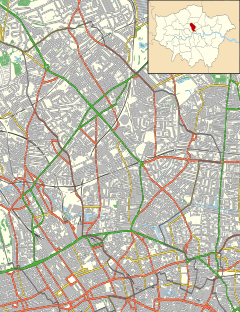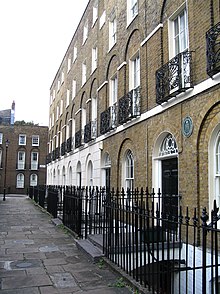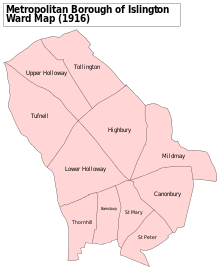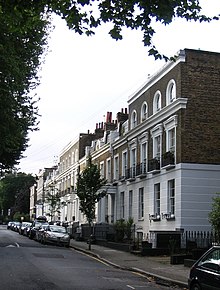Human settlement in England
| Canonbury | |
|---|---|
 Canonbury Square Gardens Canonbury Square Gardens | |
  | |
| Population | 12,072 (2011 Census. Ward) |
| OS grid reference | TQ325845 |
| London borough | |
| Ceremonial county | Greater London |
| Region | |
| Country | England |
| Sovereign state | United Kingdom |
| Post town | LONDON |
| Postcode district | N1 |
| Dialling code | 020 |
| Police | Metropolitan |
| Fire | London |
| Ambulance | London |
| UK Parliament | |
| London Assembly | |
| 51°32′37″N 0°05′18″W / 51.5437°N 0.0883°W / 51.5437; -0.0883 | |
Canonbury is an area in London, forming part of the London Borough of Islington. It is located within the area between Essex Road, Upper Street and Cross Street and either side of St Paul's Road in North London.
In 1253 land in the area was granted to the Canons of St Bartholomew's Priory, Smithfield, and became known as Canonbury. The area continued predominantly as open land until it was developed as a suburb in the early 19th century.
In common with similar inner London areas, it suffered decline when the construction of railways in the 1860s enabled commuting into the city from further afield. The gentrification of the area from the 1950s included new developments to replace war-damaged properties in Canonbury Park North and South as well as restoration of older buildings.
Geography
Canonbury is traditionally an area of Islington, and has never been an administrative unit in its own right. For this reason it has never had formally defined boundaries, but approximates to the area between Essex Road, Upper Street and Cross Street and either side of St Paul's Road. The Canonbury electoral ward within the London Borough of Islington extends as far east as Southgate Road.
East Canonbury is the south-eastern corner of the district, bordering on the Regents Canal. Parts of this area were transferred to the district from the London Borough of Hackney in a boundary adjustment (along the line of the northern towpath of the canal), in 1993.
In the east is the Marquess Estate, a 1,200 dwelling council estate, completed in 1976 on 26 acres (110,000 m), and designed by Darbourne & Darke. A dark red brick, traffic free estate, it was praised as an example of municipal architecture, but acquired a bad reputation and has since been extensively redeveloped to improve security for residents.
Places of interest
- Canonbury Tower – The manor house of Canonbury was constructed by William Bolton of St Bartholomew's Priory between 1509 and 1532. At the Dissolution of the Monasteries it was granted to Thomas Cromwell. In the 1590s the manor house was rebuilt by Sir John Spencer, Lord Mayor of the City of London, including the construction of its tower. The tower has been occupied by many historical figures, including the philosopher and Lord Chancellor Francis Bacon, and the Irish novelist and playwright Oliver Goldsmith. The Tower Theatre Company was based here from 1953 to 2003. It is currently used as a Masonic research centre.
- Canonbury Square – Developed between 1805 and 1830, it includes a variety of distinct styles. In 1812, when few properties had been built, the New North Road turnpike, now known as Canonbury Road, was constructed and bisects the square. Many significant figures from the arts and literary worlds have lived on the square, including the writers George Orwell and Evelyn Waugh, and the actor Samuel Phelps.
- The Estorick Collection of Modern Italian Art is in Canonbury Square.
- John Spencer Square – A residential garden square named after Sir John Spencer, Lord Mayor of the City of London, former residents include Barbara Castle, Labour politician and former Secretary of State, and English constitutional historian David Starkey.
- New River Walk – The New River, an aqueduct built by Sir Hugh Myddelton to supply fresh water to London, was completed in 1613. The walk is in two parts, with a break at Willowbridge. The southern section received an early National Lottery grant, and has a back-pumping scheme which simulates the water flow of the original aqueduct.
- Arlington Square – voted one of the UK's best garden squares.
Literary and artistic connections

George Orwell moved to 27b Canonbury Square in the autumn of 1944 – he and his wife having been bombed out of their previous flat, in Mortimer Crescent, on 28 June 1944. Evelyn Waugh lived at 17a Canonbury Square from 1928 to 1930. Charles Dickens wrote a Christmas story about a lamplighter in Canonbury, which features the Tower. Leslie Forbes, the travel and detective story writer, and amateur historian Gavin Menzies both lived in the area. M. V. Hughes (née Thomas) lived at 1 Canonbury Park North (the house is no longer standing) as a child, and describes life there in her memoir A London Child of the 1870s.
Churches

- St Paul's, at the junction of Essex Road and Balls Pond Road, was designed in 1826-28 by Charles Barry for the Church of England. Its parish was merged with St Jude, Mildmay and since 1997 the building has been used as a Steiner school.
- St Stephen's Church, Church of England, is on Canonbury Road and was built in 1839.
Groups in Canonbury
- Greenpeace UK – offices based at Canonbury Villas.
- The Canonbury Society aims to conserve the special character of Canonbury by monitoring development.
- Islington & Stoke Newington (T.S Quail) Sea Cadet Unit
- The Islington Society was founded in 1960 to safeguard and improve the quality of life in Islington. It focuses on the built environment and public transport, but also takes a special interest in public services and open spaces.
Politics
- Canonbury forms part of the Islington South and Finsbury parliamentary constituency. The constituency's MP is Labour politician Emily Thornberry. The Islington councillors representing Canonbury are Alex Diner, Clare Jeapes and Nick Wayne (Labour).
Demography
The 2011 census showed that the population of Canonbury ward was 72% white (53% British, 15% Other, 4% Irish), and 6% Black African.
Transport and locale
| Neighbouring areas of London. | ||||||||||||||||
|---|---|---|---|---|---|---|---|---|---|---|---|---|---|---|---|---|
| ||||||||||||||||

Nearest stations
Buses
London Buses routes 4, 19, 30, 38, 56, 73, 236, 263, 341, 393 and 476 serve Canonbury.
Education

Canonbury Road School, now Canonbury Primary School, opened in 1877. It is a Community primary school taking boys and girls from 3 to 11 years of age. In 2010, the school was placed in special measures. By 2013, when Ofsted inspected Canonbury Primary School it was rated as a "Good" school. In 2013, there were 460 pupils on the school roll.
Founded as a charity school in 1710, St Mary's Church of England Primary School has, since 1967, been situated on Fowler Road in Canonbury. When Ofsted inspected the school in 2012 it was rated as a "Good" school and there were 178 pupils on the school roll.
North Bridge House Senior School is located in Canonbury.
Notable residents

- Thomas Cromwell, Lord Privy Seal, lived in Canonbury Tower from 1533 until his execution in 1540 by order of King Henry VIII
- Sir Francis Bacon, King James I's Lord Chancellor, lived in Canonbury Tower, 1616–1626
- William Babell, musician, died here in 1723
- Ephraim Chambers, encyclopaedist, lodged at Canonbury Tower
- George Grossmith and Weedon Grossmith, actors and writers, lived at 5 Canonbury Place
- John Newbery, publisher of children's literature, lived in Canonbury House
- Christopher Smart, poet, lived in Canonbury House
- Francis Ronalds, inventor of the electric telegraph, lived at 11 Canonbury Place as a child
- Edmund Ronalds, chemist, was born at 48 Canonbury Square and later lived at the east end of Canonbury Place
- Thomas Field Gibson, Royal Commissioner for the Great Exhibition of 1851, was born at 2 Canonbury Place
- Molly Hughes, educator and author, chronicled her childhood in Canonbury in A London Child of the 1870s growing up in a house that "stood at the corner of two roads" with a view down the length of Grange Grove (1 Canonbury Park North)
- George Orwell, writer, lived at 27b Canonbury Square
- Evelyn Waugh, writer, lived at 17a Canonbury Square
- Duncan Grant and Vanessa Bell, painters and designers, lived at 26a Canonbury Square
- Professor Sir Basil Spence, architect, lived and worked at 1 Canonbury Place from 1956 until his death in 1976. He is commemorated with a blue plaque
- Dame Flora Robson, actress, lived in Alwyne Villas
- Louis Macneice, poet, lived at 52 Canonbury Park South from 1947 to 1952 and is commemorated with a blue plaque
- Barbara Castle, politician, and Ted Castle, journalist, lived in John Spencer Square
- Alan Davies, actor/comedian
- Spider Stacy, founding member of the Pogues
- Harry Randall, music hall and pantomime comedian lived at 4 Canonbury Grove and 2 Alwyne Place
- Cate Blanchett, actress, lived at 7 Canonbury Grove
- Chester P, UK hip-hop artist, member of Task Force and M.U.D. Family
- Dame Stella Rimington, head of MI5, lived at 7 Canonbury Grove, in Alwyne Road and in Alwyne Place
- Sir John Mummery PC, DL, a Lord Justice of Appeal
- Sir Nicholas Barrington, ex UK High Commissioner to Pakistan
- William Greaves, co-founder of Capital Kids' Cricket lived at 13 Canonbury Grove
- Charlie Weaver, member and front man of Lonsdale Boys Club
- Sir John Tusa, broadcaster and arts administrator
- Kenneth Griffith, actor, producer, presenter and historian, lived at 8 Alwyne Place, which he named Spion Kop
- Dido, singer, lived at 1 Willow Bridge Road
- Alison Moyet, singer, lived at 6 Alwyne Road
- Keira Knightley and her husband James Righton moved into Canonbury in 2014
- Kit Harington, actor, moved into Canonbury in 2015
- James Bay, singer, moved to Canonbury in 2016
- Gareth Morris, principal flute, Philharmonia and New Philharmonia Orchestras (1948–1972) also principal flute professor of Royal Academy of Music (1945–1985), resident of 4 Alwyne Place from 1945 to 1987
- Allegra Stratton, Downing Street Press Secretary from 2020 to 2021, and her husband James Forsyth, political editor of The Spectator
- Emma Watson, actress, lived at 2 Canonbury Place
References

- "Islington Ward population 2011". Neighbourhood Statistics. Office for National Statistics. Archived from the original on 24 October 2016. Retrieved 24 October 2016.
- ^ 'Islington: Growth: Canonbury', A History of the County of Middlesex: Volume 8: Islington and Stoke Newington parishes (1985), pp. 19-20 accessed: 3 May 2007
- Statutory Instrument 1993 No. 1417 accessed 3 May 2007
- "Keep Britain Tidy reveals nation's 10 most popular parks | Horticulture Week".
- Orwell, Collected Works, I Have Tried to Tell the Truth, p.283
- Eric A Willats, Streets with a Story
- The Lamplighter Charles Dickens (Public Domain) accessed 29 September 2009
- Raymond, Francine (13 May 2018). "The Embroidered Minds Epilepsy Garden: A Chelsea show garden of the mind". The Telegraph. Retrieved 30 September 2023.
- Hitt, Jack (5 January 2003). "Goodbye, Columbus!". The New York Times. Retrieved 30 September 2023.
- ^ Foxed, Slightly (14 November 2020). "Accentuating the Positive". Slightly Foxed. Retrieved 4 December 2024.
- "St Paul, Essex Road, Canonbury". London Churches in photographs. 15 December 2013. Retrieved 14 January 2016.
- "St Jude and St Paul Mildmay Grove". Diocese of London. Archived from the original on 13 June 2018. Retrieved 14 January 2016.
- "St Paul Steiner school". Retrieved 14 January 2016.
- "St Stephen, Canonbury Road, Canonbury". London Churches in photographs. 15 December 2013. Retrieved 14 January 2016.
- "St Stephen's Canonbury". Retrieved 14 January 2016.
- "Welcome to the Canonbury Society". The Canonbury Society. Retrieved 7 January 2022.
- "The Islington Society". Retrieved 7 January 2022.
- Services, Good Stuff IT. "Canonbury - UK Census Data 2011". UK Census Data. Retrieved 5 September 2019.
- "Buses from Canonbury" (PDF). TfL. 30 June 2018. Archived (PDF) from the original on 23 February 2020. Retrieved 23 June 2020.
- "The History of Canonbury Primary School, Islington". www.locallocalhistory.co.uk. The School Detective. Retrieved 19 October 2016.
- Blunden, Mark; Ross, Tim (18 June 2010). "Boris Johnson primary Canonbury fails Ofsted report". Evening Standard. Retrieved 19 October 2016.
- "Canonbury Primary School: Ofsted Report". www.canonburyprimaryschool.co.uk. Canonbury Primary School. Retrieved 19 October 2016.
- "Canonbury Primary School: Ofsted Report 2013" (PDF). www.canonburyprimaryschool.co.uk. Canonbury Primary School. Archived from the original (PDF) on 20 October 2016. Retrieved 19 October 2016.
- "History of St Mary's Church of England Primary School". www.stmarys.islington.sch.uk. Archived from the original on 20 October 2016. Retrieved 19 October 2016.
- "St Mary's CE Primary School: Ofsted Report 2012" (PDF). www.stmarys.islington.sch.uk. St Mary's Islington. Archived from the original (PDF) on 20 October 2016. Retrieved 19 October 2016.
- "Contact Us Archived 2 April 2015 at the Wayback Machine." North Bridge House School. Retrieved on 26 March 2015. "North Bridge House Senior School & Sixth Form - Canonbury6-9 Canonbury Place London N1 2NQ"
- Ronalds, B.F. (2016). Sir Francis Ronalds: Father of the Electric Telegraph. London: Imperial College Press. ISBN 978-1-78326-917-4.
- Ronalds, B.F. (2019). "Bringing Together Academic and Industrial Chemistry: Edmund Ronalds' Contribution". Substantia. 3 (1): 139–152.
- "Thomas Gibson & Thomas Field Gibson". Dictionary of Unitarian and Universalist Biography. Archived from the original on 4 May 2022. Retrieved 20 November 2017.
- "Spence, Basil (1907–1976) Plaque erected in 2011". English Heritage. Retrieved 14 January 2016.
- "Greater London, Islington, Canonbury Place, General | Canmore". canmore.org.uk. Archived from the original on 27 July 2020. Retrieved 6 May 2020.
- "Broadcaster Sir John Tusa pens a tribute to his home patch of Canonbury". Archived from the original on 13 March 2016. Retrieved 16 January 2013.
- "Canonbury's celebrity status is confirmed as Keira Knightley moves in". Homes and Property. 7 January 2014.
- "Allegra Stratton's My London". Evening Standard. 28 March 2013. Retrieved 31 December 2014.
External links
- Canonbury Masonic Research Centre
- Tower Theatre Company
- BBC WW2 People's War - Joan Windsor's WW2 experiences (including bombing raid on Essex Road)
- The Canonbury Society

